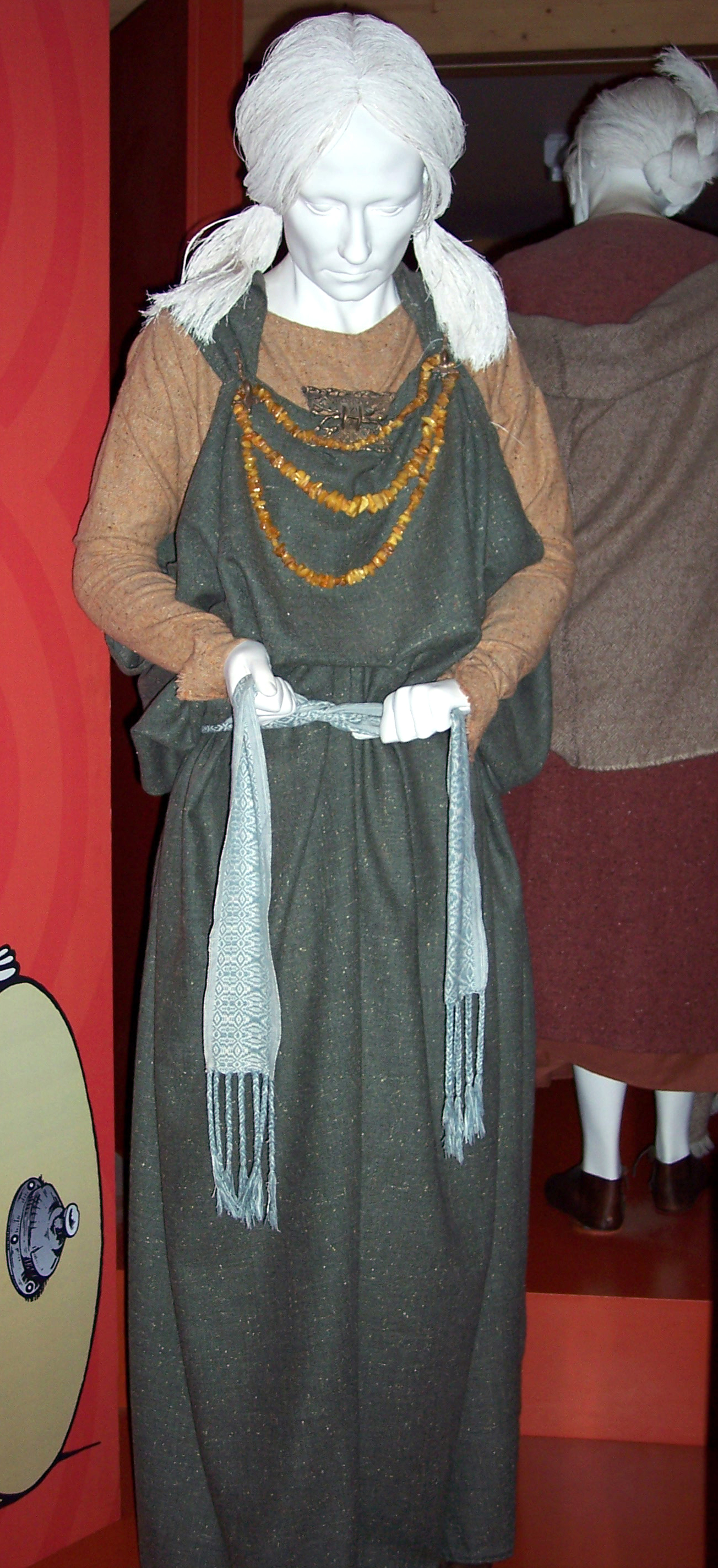
AngloSaxon Woman Celtic Clothing, Medieval Clothing, Historical
This article addresses the evidence for Anglo-Saxon dress in relation to these criteria. From the evidence of grave-goods, it is possible to sketch reconstructions of clothing. Women's costume changed several times during the Anglo-Saxon period, apparently in response to foreign and religious stimuli, men's hardly at all.

Anglo Saxon woman's dress Anglo saxon clothing, Medieval clothing
Harold Godwinson, last Anglo-Saxon king of England, as depicted in the Bayeux Tapestry.He is shown wearing a tunic, cloak, and hose. Anglo-Saxon dress refers to the clothing and accessories worn by the Anglo-Saxons from the middle of the second century to the eleventh century. Archaeological finds in Anglo-Saxon cemeteries have provided the best source of information on Anglo-Saxon costume.

10 Fascinating Facts About AngloSaxon England that Will Impress Your
The most common Anglo-Saxon clothes for women were black or brown woolen gowns. All women wore some type of head covering, but many did not wear shoes until the later Anglo-Saxon period. Women's clothing styles also changed as Christianity spread across Britain from the 6th century onwards. Clothing styles also varied between.

Pin auf MWZ Darstellungen
ANGLO-SAXON CLOTHES. Find out what the Anglo-Saxons wore then . How did the Anglo-Saxons make their clothes? How and who would have worn or used these? Buckles. Beads. Brooches. Comb. Toilet Set . What did the Anglo-Saxons wear? Anglo-Saxon men. Anglo-Saxon women. Anglo-Saxon children :

Saxon Women Dress AngloSaxon Clothing NEN Gallery The 10th
Kretschmer, Albert. " Anglo-Saxon Clothing, 6-9th century CE ." World History Encyclopedia. World History Encyclopedia, 27 Jun 2018. Web. 12 Jan 2024. An illustration of the typical clothing worn by Anglo-Saxons in medieval England, c. 500 - c. 1000 CE. ('Costumes of all Nations', 1882 CE)

Anglo Saxon kit A Damsel in This Dress Anglo saxon clothing
English medieval clothing. The Medieval period in England is usually classified as the time between the fall of the Roman Empire to the beginning of the Renaissance, roughly the years AD 410-1485. For various peoples living in England, the Anglo-Saxons, Anglo-Danes, Normans and Britons, clothing in the medieval era differed widely for men and.

Anglo Saxon woman's dress Anglo saxon clothing, Anglo saxon, Saxon
Source over 2 million products in more than 40 product categories. Source Direct from Global Suppliers - Low MOQ, Great Deals, Customizable

Low status woman thrall! Anglo saxon clothing, Anglo saxon, Celtic
This is how an Anglo-Saxon man dressed (Click on the picture to take a closer look) How do we know what Anglo-Saxon men wore? We cannot be sure exactly what an Anglo-Saxon man would have worn, but we can make a guess based on objects found in graves, from drawings in Anglo-Saxon books and images on objects. He wore wool or linen trousers.

267 best ANGLOSAXON Costume images on Pinterest Middle ages, Anglo
Making clothes was women's work, and spinning and weaving were among the main activities of women in the Anglo-Saxon period. It has been estimated that about eight miles of hand-spun thread were needed to make a tunic. The loom in general use in Anglo-Saxon England was the warp-weighted upright wooden loom, leaned against a wall either.

Pin on SCA and Medieval Historical Costuming
Anglo-Saxon Adam and Eve from the Caedmon manuscript, c. 950.The angel wears iconographic dress. English ploughmen, c. 1000. Early medieval European dress, from about 400 AD to 1100 AD, changed very gradually.The main feature of the period was the meeting of late Roman costume with that of the invading peoples who moved into Europe over this period.

Anglo Saxon Clothing NEN Gallery
The poorer Saxons would have clothes made from natural materials and leather, so they would often have brown, black, green or yellow coloured clothes. The most common materials were wool and linen. They were extremely plain, with the occasional decorative pattern or brooch. The wealthier Anglo Saxons would have their clothing dyed, so they.

246 best images about ANGLOSAXON Costume on Pinterest Woman costumes
The clothes of the Anglo Saxon kings during the early period were fairly similar to the general clothes of men in Anglo Saxon society. A distinguishing feature of the king's clothing was the use of a leather tunic upon which rings were sewn. The king also wore a longer and more elaborate cloak. By the 9th century, silk was extensively used in.

Reconstruction of Anglo Saxon mens clothing Anglo Saxon History
Anglo-Saxon clothes. Anglo-Saxons made their own clothes out of natural materials. The men wore long-sleeved tunics made of wool or linen, often decorated with a pattern. Their trousers were woollen and held up by a leather belt from which they could hang their tools such as knives and pouches. Shoes were usually made out of leather and.

IMG_4919.jpg Anglo saxon clothing, Anglo saxon history, Anglo saxon
Anglo-Saxon clothing remained the most visible aspect of the Anglo-Saxon culture in England from the 5th to 11th centuries. During this period, Anglo-Saxons transformed from nomadic, migrating tribes to those settled down in specific locations and evolved into smaller kingdoms which eventually morphed into a unified and centralized Anglo-Saxon kingdom.

First attempt at early AngloSaxon peplostype dress. All linen
Anglo-Saxon man in traditional dress. 5th and 6th centuries. Men wore wool or linen hip-length undershirts with long sleeves, and probably loin-cloths. Woollen trousers were held up with a belt threaded through loops. A tunic was pulled over the head, and reached down to the knees. It was usually decorated at the wrists, neck and hem, and was.

Pin on Medievally Stuff
The Craftsmanship Behind Anglo-Saxon Clothing Creating clothing in the Anglo-Saxon era was a labor-intensive process that involved skilled craftsmanship and a deep understanding of natural resources. From the careful spinning and weaving of yarns to the delicate art of embroidery and dyeing, every piece of garment was a testimony to the craftsperson's dedication.